## Old Man's Beard: A Comprehensive Guide
Old Man's Beard (Clematis vitalba), a member of the Ranunculaceae family, is a vigorous, deciduous climbing plant known for its impressive, fluffy seed heads that resemble an old man's beard—hence the name. This plant, while visually striking, is often considered an invasive species in many parts of the world.
### Habitat and Growth
Native to Europe and parts of Asia, Old Man's Beard thrives in a wide range of habitats. It's particularly fond of disturbed areas, hedgerows, woodlands, and even urban environments. Its rapid growth and tenacious clinging ability allow it to quickly cover fences, walls, and trees, sometimes smothering other vegetation. This aggressive growth is a major reason for its invasive status in certain regions. It's important to note that its ability to climb is due to its twining petioles, not tendrils like some other climbers.
### Identification
Identifying Old Man's Beard is relatively straightforward, especially during the late summer and autumn months when its distinctive seed heads are present. The plant itself has opposite, pinnate leaves with 3-5 leaflets. The flowers are small, creamy-white, and rather inconspicuous. However, the showy, fluffy seed heads, composed of numerous long, silky styles, are unmistakable.
### Sun Exposure and Soil Needs
Old Man's Beard is adaptable to various sun conditions, tolerating both full sun and partial shade. It prefers well-drained soil, but it can tolerate a wide range of soil types, including those that are dry or somewhat infertile. Its ability to thrive in various conditions contributes to its invasive potential.
### Potential Problems and Control
The vigorous growth of Old Man's Beard can be problematic. It can outcompete native vegetation and damage structures due to its heavy weight. Control methods include manual removal (cutting and digging out), herbicide application (with appropriate safety measures), and careful management of its spread.
### Uses and Folklore
Historically, Old Man's Beard has had some uses. The flexible stems have been used for basket weaving, and extracts have been used in traditional medicine, although its medicinal properties are not widely researched or accepted in modern healthcare practices. In some cultures, its seeds have symbolic meaning.
### Conclusion
Old Man's Beard is a fascinating plant with a striking appearance, but its invasive tendencies need careful consideration. Understanding its characteristics and potential problems is vital, whether you encounter it in the wild or are considering it for cultivation (which is generally not recommended in areas where it's considered invasive).
Remember always to check with your local authorities before undertaking any action related to planting or removing any plant species. Respecting the local ecosystems is crucial for biodiversity preservation.
Old Man's Beard: A Complete Guide

Frequently Asked Questions
How to identify Old Man's Beard?
Look for its distinctive fluffy, white seed heads in late summer and autumn. The plant itself has opposite, pinnate leaves with 3-5 leaflets and small, creamy-white flowers.
Is Old Man's Beard poisonous?
While not highly toxic, some parts of Old Man's Beard may cause skin irritation in sensitive individuals. It's best to avoid direct contact, and always wear gloves when handling it.


